Fifteen pamphlets. That's what I bought on Wednesday. Dear Lord, I have a problem. Somebody may need to organize an intervention.
And they were, for the most part, damned fine reading. Truly we are in the Golden Age of Comics!
Before time runs out, I should mention that Jason Rodriguez is giving away a copy of Neil Kleid and Jake Allen's
Brownsville, which is a very good graphic novel that I will review any day now!
Go here for details. It's a very good book that costs almost 20 dollars, and Jason is giving it away! Visit today, because it's the last day to enter!
Anyway, on to the singles purchases! Our theme this week is "fun" comics versus "funny" comics, and why the former are usually better than the latter. Usually, but not always.
The American Way #2 (of 8) by John Ridley, Georges Jeanty, Karl Story, and Ray Snyder
$2.99, DC/Wildstorm
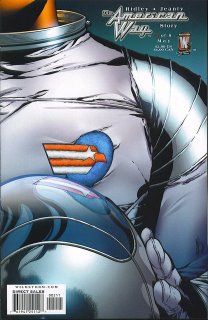
I know I said I was going to stop reading mini-series after the first issue until they were completed, but I was on the fence about continuing with this one, so I figured I'd read the second issue to help me make up my mind.
Well, now I'm decided. This is a big improvement on the first issue, and I liked the first issue. The second one, however, expands on the decent story that Ridley conjured up in the first one. After the death last issue of Old Glory, we get two consequences: first, the CDC needs a replacement, and Wes comes up with a brilliant idea: get a black man to replace him! This leads to some hemming and hawing among the government types, but they finally decide to go with it. A majority of the issue is trying to get Jason Fisher to agree with their plan, as well as a brief discussion about race in the early 1960s and the reveal that some of the superheroes are racist (yes, it's predictable, but it should be interesting to see the dynamic once Jason joins full time). The second consequence is that Johnny Lau, who played the part of Red Terror and was fighting Old Glory when he died, goes a bit crazy because he believes that he has superpowers (Old Glory actually died of a heart attack, but Lau doesn't know that). Meanwhile, the market researchers at CDC decide to send Pharos and Freya on a date, with disastrous results. The implication is that Pharos is gay, and it will be interesting to see the results of that little thread. (Okay, maybe you read it differently. Maybe I'm just a weirdo who sees homos everywhere. There's one under the bed! Right there! But I think that's the implication. We'll see.)
This is a strong second issue, and it makes the world of the early 1960s come more alive than the first. I'm on board for good, which means I'll read the complete mini-series around Thanksgiving.
Batman #651 by James Robinson, Don Kramer, and Keith Champagne
$2.50, DC
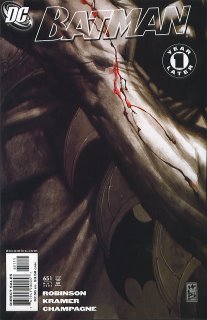
As a second of eight issues in this story arc, this is a bit disappointing, and certainly not as strong as the first one in Detective. The sense of mystery is still there, a bit, and Robinson introduces a character who will somehow intersect with Batman in the future, but he keeps it nice and vague, and Batman is working nicely with Robin instead of, you know, yelling at him, but it's still a bit of a disappointment. First of all, and I guess I should warn you that I'm spoiling the ending ...
But isn't Magpie dead already? I thought I read somehow (perhaps in the Superman/Batman: Public Enemies trade paperback?) that she was dead. It's a minor thing, because she's just dead as a plot contrivance, but it's nagging me.
Second of all, our heroes take care of Poison Ivy just a tad quickly. She says she's stronger than ever, but they beat her pretty easily. It's nice that Batman sets himself up as the bait while Robin does all the heavy lifting, but it still seems ... easy.
Those are just minor tics, though, because it is, after all, an eight-issue arc. I liked the first part a lot, so I guess I should expect a bit of a downer this issue. But our heroes better start detecting soon!
Catwoman #53 by Will Pfeifer, David Lopez, and Alvaro Lopez
$2.50, DC

Oh, that crafty Will Pfeifer! He starts out just okay on the title, then hits us with an excellent pre-One Year Later issue, so I had to come back for the post-One Year Later issue! Well played, Mr. Pfeifer!
He's getting better at it, too. This is certainly an intriguing issue, as Pfeifer sets up the One Year Later scenario - after killed Black Mask, Selina can't return as Catwoman, so she disappears. She comes back and has a baby. That was handy! In a great scene, Batman brings her a stuffed bear. Excellent! Meanwhile, Holly is running around dressed as Catwoman, and the Angle Man wants to kill her, but he doesn't know it's not Selina! Oh, the drama! So at the end, she's in peril. Of course.
It's a nice issue, as Selina debates Batman about the wisdom of letting a youngster dress up and run around beating people up. And Slam Bradley shows up, looking fully recovered from his ordeal. And who's the father? I hope that becomes an important point in the near future, because it could be a fascinating storyline.
Anyway, it's not necessarily the best "jumping-on" point, but it's a good book. Oh, and the art is good. Not as good as Woods' was, but I like Lopez, and he knows what he's doing.
Daredevil #83 by Ed Brubaker, Michael Lark, and Stefano Gaudiano
$2.99, Marvel
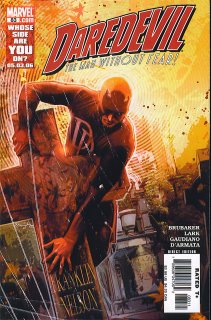
That's pretty funny that Brubaker has everyone thinking that Foggy is actually dead. Good job, Ed!
He's not, of course. Come on, people! Dakota North, last page: "And then in the ambulance, I thought he'd be okay, y'know ... They said he was stabilizing ..."
Come on, people!
I'm not ready to pass judgment on this title quite yet, although I disagree with Brian that it's Miller-esque, and lean more toward T. that it's much more Bendis-esque. I suppose it would have to be, because Bendis stuck him in jail, after all, and Brubaker has to make it work. But the focus on Matt, specifically, and Urich's personality smack of Bendis. That's fine - I can deal with it as we transition. It's still an interesting predicament that Matt will have to get out of. And it's always good to see Matt kick some ass.
Not much to say about this. It's a (sigh) six-issue arc, so we'll see how it goes. And I don't much care who the new Daredevil is. It could be Spider-Man, sure, but we'll find out eventually. I'll say it's ... the Jester!
The Iron Ghost #6 (of 6) by Chuck Dixon and Sergio Cariello
$2.99, Image
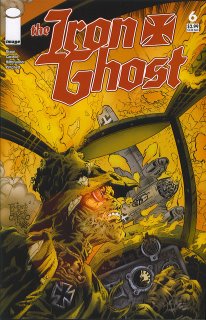
The Iron Ghost finally wraps up after a hurricane-delayed schedule, and it's a fine, fine mini-series that you should look for in trade. It's another example of a lousy mystery in comics - the killer is revealed at the end of issue #5, and the only clue leading us to him is also revealed in issue #5, so it's a cheat by Dixon - but it's a good story that asks some important questions: Should we care about these characters, since they're all stinkin' Huns in the Second World War? Is the Iron Ghost a noble figure, or should he maybe have done something about this years ago? Is Josef Meier a noble figure, or should he maybe have done something about this years ago? In a weird way, this little mini-series from Image asks the same questions that (wait for it!) V For Vendetta does - if one is fighting against a monstrous government, is it necessary to become a monster oneself? Is the Iron Ghost insane or not? His motivation seems a little weak, so I would lean toward insane, but you could argue both ways. Is the Iron Ghost even a hero, because he's not really killing people simply because they're part of the Nazi regime, but they have done some horrible things. It's a very interesting story, and I hope the trade sells well. We need more Chuck Dixon War Comics! Go Buy Team Zero!
Nextwave #3 by Warren Ellis, Stuart Immonen, and Wade von Grawbadger
$2.99, Marvel

Here's an example of a fun comic that I didn't find particularly funny. Ellis' idea of funny, unfortunately shared by many in his audience, is to repeat the fact that Fin Fang Foom is wearing purple pants several times. And to have Tabitha and Monica call Elsa an "English ----" (I assume they're using the c-word, which I will not use - ever). And have a sign that reads: "Sink City Very Small School With Lovely Children Inside." Guess what, Warren? That's not funny. I still dig Nextwave, however, because it is a fun comic. It takes itself not seriously at all, it offers up interesting villains (Ellis is good at coming up with threats), and it breezes through the destruction of said villains. Here we have a crooked cop who somehow turns into a car-eating robot, and our heroes must defeat him. In the most brutal way possible, probably, and with a great deal of mayhem. A nice, fun comic about beating up the bad guys. What the hell is wrong with that?
Oh, and the letter in the letter column, deconstructing Toto? Now that's funny.
Noble Causes #18 by Jay Faerber, Fran Bueno, and Freddie E. Williams
$3.50, Image
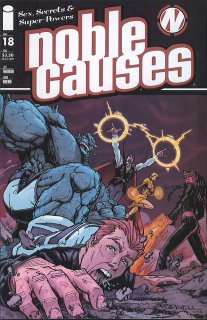
And what do you know? The best superhero book around shows up this week! I told Jake that I would buy Invincible if he bought Noble Causes, so he better get to it! The Blackthorne saga continues to unfold, as the Blackthornes hire the wonderfully-named Widowmaker (who can, apparently, use sex as a weapon) to take out Race and Liz. When she is about to, however, the Blackthornes themselves show up and stop her! They become media darlings! Whatever could their plan be???? We also learn that although Race didn't kill Pierce Blackthorne, he thinks he's responsible, and feels really guilty. Oh, the angst!
As usual with books I really like, it's hard to say much about this. After the first twelve issues were all over the place, eventually coming together in a rousing climax, Faerber has kept things pretty tightly focused over the past six issues. Things are certainly brewing, but they're all brewing in the same place, generally, with the same group. So it will be interesting to continue to watch events unfold.
Buy Noble Causes, people. Would it really kill you?
Planetary Brigade #2 by Keith Giffen, J.M. DeMatteis, and various artists
$2.99, Boom! Studios
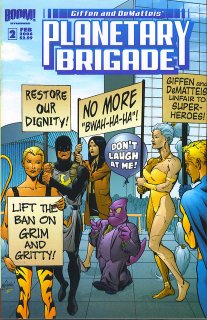
This came out last week, but Ross Richie must have some kind of East Coast bias, because we Westerners got shafted and it didn't get here until this week! Confounded distributors! We in the West have rights, you know! Maybe it's time for ¡La Revolucíon!
Okay, where was I? Oh yes. Here's another fun comic that isn't particularly funny. This reminds me more and more of the early "funny" Justice League issues, when Giffen and DeMatteis were writing really good superhero stories that happened to have funny comments occasionally. You know, before KooeyKooeyKooey! In this issue, they fight that portal guy, from whom demons keep jumping, and they don't do very well. They make lots of pithy and witty comments, but none distract from the "drama" (so to speak) and they all work with what little we know so far about the personalities of the characters. Captain Valor, for instance, doesn't make funny sexist remarks about his teammates, but Mister Brilliant does. So it's a nice read because DeMatteis reveals the characters through their interaction.
Some might object to the depressing resolution to the book. It's a "fun" book, after all. But again, there's a difference between "fun" and "funny," and although this is often "funny" (more so than Nextwave, at least), it doesn't exist simply for the sake of slapstick. When things get serious, we appreciate the way these characters can joke around in the face of death and still get the job done. So the joking becomes something more - a defense mechanism, even. And, apparently, our heroes are going to need it.
This is a fine title. Mr. Richie and his East Coast Intellectual Liberal Bias is forgiven.
Rex Mundi #17 by Arvid Nelson and Juan Ferreyra
$2.99, Image

One of my favorite titles seems to be back on schedule, which is good news, because it's a pain waiting months for an issue to come out. This is the second issue with Ferreyra on art, and it's as strong as ever. One of the nice things about Ferreyra's art is he gives each character a distinct look, and we can easily see what each person is thinking through only their facial expressions. The issue, unfortunately, isn't one of the stronger ones, simply because it's heavy on exposition, as Julien and Genevieve follow the Duke of Lorraine to a chapel in the woods and discover yet more secrets about the Grail and the history of France. I like the book A LOT more when it doesn't tack so closely to ground covered in recent novels and "histories," and in this issue, it does far too much of that. However, there's a nifty fight with a golem, which mitigates that a bit.
According to Nelson, we're now about halfway through the entire epic, and it's good to see that we're proceeding with the same deliberate (not necessarily slow, just deliberate) pace and that things are unfolding in an organic fashion. As I usually write when an issue comes out, it's not for everyone, but Rex Mundi is the kind of comic book that shows the endless possibilities of the medium.
She-Hulk #6 by Dan Slott and Will Conrad
$2.99, Marvel

If Marvel is trying to drive me away from a book simply because of the horrible covers, then they're doing a fine job of it with Greg Horn on She-Hulk. They're just awful. And still completely out of sync with the tone of the book. Blech.
She-Hulk is another book that is fun but not necessarily funny, and it works because of that. Sure, occasionally it's goofy and wacky and makes you laugh, but it's more a comic that makes you smile with appreciation of the ideas that are being presented and the way in which Slott executes them. Especially for someone like me, without a Cronin-esque knowledge of the Marvel U. and therefore doesn't know if Starfox has ever been sued for sexual harassment before and finds it interesting. The fact that it appears Starfox simply can't control whatever it is that oozes out of him and makes people fall head over heels for anyone who's around them is another interesting facet of the book. (Can he control it, people? I'm definitely not up on my "What's the extent of Starfox's power" bit.) So everyone around him is affected, and one wonders if they know, because that could be a problem when it comes to trial. How can he get a fair trial if everyone loves him?
Like I said, a lot of good stuff here. We wonder what Mr. Zix's agenda is. We chuckle when Starfox attacks Andy because he thinks our favorite android is a villain. We feel bad for Pug, because he keeps getting distracted when he tries to put the moves on Jen. It's very soap opera, but it works in a slight book like She-Hulk. A fun comic. Which is why you should buy it.
Supreme Power: Hyperion #5 (of 5) by J. Michael Straczynski, Dan Jurgens, Staz Johnson, and Klaus Janson
$2.99, Marvel
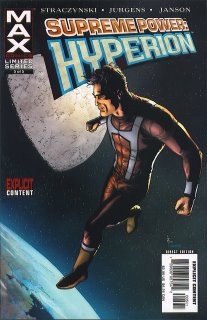
I had to write about this before Squadron Supreme, since it comes before it chronologically, even though it means I'm out of alphabetical order! Please forgive me, blogaxy!
Meh. This certainly wasn't as bad as the Nighthawk mini-series, but it wasn't anything special, either. It's like cold oatmeal: you'll eat it, but you certainly won't ask for more or tell everyone what a wonderful meal you just had. It sets the stage for the new series, and the fact that the group was in the future instead of an alternate present is interesting, but other than that, meh.
Squadron Supreme #1 by J. Michael Straczynski, Gary Frank, and Jonathan Sibal
$2.99, Marvel
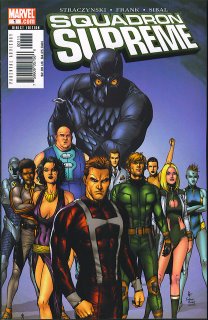
Which is a shame, because as you know, I was a fan of Supreme Power, and now that Marvel has decided that we delicate fans simply can't handle Zarda's or Kingsley's breasts anymore and moved the title out of the MAX imprint, we get a new series. This is more like it - it appears that everything I liked from the first series, including the glacial pace, is back! Yes, the glacial pace is what turned everyone off the first time, and I have a feeling Marvel is publishing this simply to keep Straczynski happy and on their big books, but I like the pacing, because it's not necessarily written for the six-issue trade; it's more like it's written for the fifteen-issue hardcover, and that's fine. General Alexander assembles the two teams - one a public one, the other secret - but Mark Milton gives the names of the covert one to the press before it's even announced. You know, just to mess with the government. We meet a few new members to the team, and the government, surprisingly enough, underestimates and dismisses Nighthawk. Boy, I sure hope that doesn't bite them in the ass!
Frank's hiatus, presumably to get a long lead time for the new series, is over, and it's a good thing, because his art is typically gorgeous. I hope he's got a lot in the can so he can stay on schedule!
I really hope Straczynski has a couple of years plotted out and then ends it. This is a concept that really has to have a finite structure, and I doubt if the series sells terribly well, so I hope Marvel lets him tell his little story and doesn't push for an open-ended series. Because that would be foolish.
Supermarket #2 by Brian Wood and Kristian
$3.99, IDW
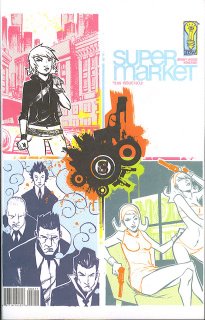
Here's a second issue that lives up to the promise of a decent but not spectacular first issue and raises the ante a bit more, making this a much more interesting series. This issue is rather speedy - it's basically a chase scene, with a few quiet pages interspersed - but it gives us a bit more insight into Pella and her parents and what the hell is going on. Since Mr. Wood nicely stopped by when I reviewed issue #1 and told me not to take it too seriously, I didn't, and he makes it easier by giving us more about Pella's character and how conflicted she is about her teenage rebellion. This is most noticeable on the full-page drawing of the food court, where she rails against the edible horrors that are served there and then, in a close-up at the bottom of the page, thinks "My God, I am so fucking hungry." That made me laugh, whether it was supposed to or not.
Pella is chased by Asian bad guys and Swedish bad girls (don't ask - just read the book!) and finds an ally, maybe, and learns more about who she is and who her parents were. Like I said, it's a speedy issue, but very fun. As usual with IDW, the price may be an issue for you, and I understand, but it's still an interesting comic with a lot of potential. Maybe someday I'll do a post about why I like certain Brian Wood books and not others. For now, this is firmly in the former camp. Let's hope it stays there!
X-Factor #5 by Peter David and Dennis Calero
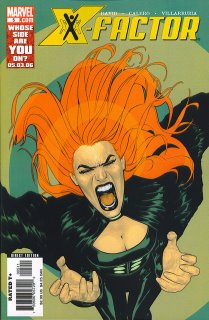
Speaking of bad covers, what the hell? That's just weird. Not particularly ugly, just off. Somehow.
This was a bit disappointing of an issue, not because it was bad, but because after the frenetic pace of the first four, it was jarring to focus simply on two characters - Siryn and Rictor, and what happened to Theresa after she was assaulted last issue. She was dragged away to an abandoned theater, where an ex-doctor and ex-mutant is a bit peeved at her because she still has her powers. He's 'round the bend, of course, and is going to do nasty things to her, but not if Rictor can find her in time!
Uh, he does. Not to ruin it or anything. But what's interesting is the conversation the doctor and Theresa have about being a mutant and how the "decimation" has affected those mutants we don't know about. The contrast between the doctor, who is a bit nuts and has no friends, and Rictor, who has a network of people to back him up, is nice and, I'm sure, what David is going for. Well, he succeeds. The only problem I have with the issue is that I'm not sure we needed the whole issue to do it. The doctor is clearly nuts, and he rambles a lot, so I'm not positive he deserved all that time. It's a minor point, and I still liked the book.
Meanwhile, Sook is gone. Goodbye, Sook! Questions abound about who the regular artist will be! I hate to be a sourpuss, but when you launch a new series, is it really too much trouble to ask that you get an artist for at least six months or so? What the hell, Marvel?
X-Men #184 by Peter Milligan and Salvador Larroca
$2.50, Marvel

Well, the art in this issue is absolutely spectacular. Larroca is credited with "washes" in this issue, whatever the hell that means, but whatever it is, the art is gorgeous. Our good guys are "soft" in style, while Apocalypse is "hard," and it really makes the contrast between their agendas stand out. Interesting.
The story ... well, it's there. Gambit becomes Death, for some reason (he explains in the back-up story, but it's still muddled), and Ozymandias betrays Apocalypse and leads the X-Men into the sphinx for a big showdown, and mutants I thought long dead are there, but who knows who's dead or alive anymore, really. It's Apocalypse versus the X-Men. Do we really need to know any more?
This is a very frustrating title, and after this big story, I'm going to make a decision whether to stay when Carey comes aboard. We'll see. Milligan is pissing me off, because he writes small scenes so well, but none of his big stories has really been all that satisfactory. If he kills Gambit, all will be forgiven. Man, I hate Gambit.
Holy crap, that's a lot of books. Am I sick? Do I need help?Read More





















